Glossary of Terms
Courtesy of Wellington's Military Machine by Philip J Haythornthwaite, England Heritage Guide to Martello Tower No. 24 and the Towers of Strength by W H Clements

Abatis: barricade of felled trees.
Aide-de-Camp: junior staff officer attached to a general.
Ammuzette/Amusette : large-bore firearm or 'wall piece'.
Armed Association: local volunteer corps raised for the protection of its own locality.
Ashlar: Square-hewn stones
Ball (as in 'ball ammunition'): musket-ball or cartridge.
Banquette: firing-step behind a parapet.
Barbette: position in which guns are mounted to fire over a parapet rather than through embrasures in the parapet wall
Bastion: (1) a four-sided fortification; (2) a design of uniform-lace, following the same shape.
Batardeau: dam to retain water in a fortress-ditch.
Battalion company: 'centre' company of an infantry battalion.
Batter: Backward slope of the surface of a wall.
Battery: gun-emplacement; later came to refer to an artillery unit of 6 guns.
Bengal lights: carcass composed of saltpetre, sulphur and red orpiment.
Blacking ball: blackening-agent for equipment.
Bomb: mortar-shell; loosely applied to all explosive projectiles.
Bombardier: junior NCO, Royal Artillery.
Breastplate: small metal badge worn on a shoulder-belt.
Breastwork: protective parapet or barricade.
Bricole: (1) rope or strap used for manhandling a cannon; (2) a cannon fired 'en bricole' when the shot struck a sloping revetment.
Brigade: (1) tactical formation of two or more battalions; (2) artillery company.
Brown Bess: affectionate name for British military musket; `to hug Brown Bess': to serve as a soldier.
Find out more
Brown George: an 'ammunition' loaf, or military issue of bread.
![]() top of page
top of page
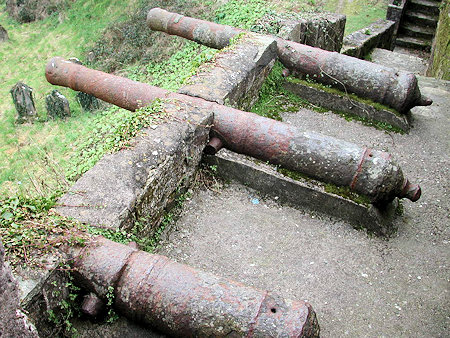
Battery of Cannons

'Brown Bess' Musket
Cacadore: Portuguese light infantry (lit 'hunter').
Canister: artillery ammunition comprising lead balls in a tin.
Cap: general term for military head-dress.
Caponniere: covered communication-trench from an enceinte to a detached work, or a casemated fortification projecting across a ditch for delivering flanking-fire.
Capsquare: metal plate securing the trunnions of a cannon to the carriage.
Captain-lieutenant: officer commanding the company nominally led by the battalion colonel. Carbine: short cavalry musket.
Carcass (or carcase): incendiary or illumination-shell.
Carronade: large-calibre, short-range cannon.
Cascabel: knob at sealed end of a cannon-barrel.
Casemate: a fortified gun emplacement or armoured structure from which guns are fired.
Case-shot: numerous small metal balls packed into a canister that bursts when fired from a
muzzle-loading gun. Used as an anti-personnel weapon
Cavalier: raised battery, usually inside a bastion. Centre company: 'battalion company'.
Chemin des Rondes: sentry-walk around the top of a revetment.
Cheval-de-frise: barricade made of stake- or blade-studded beams.
Chinese light: illumination-flare composed of nitre, sulphur, antimony and orpiment.
Chock: quoin - wooden block used for elevating a cannon-barrel.
Chosen man: lance-corporal.
Chute: sloping channel on the first-floor entrance of a Martello Tower where the removable entrance ladder fitted.
Citadel: four- or five-sided strongpoint.
Clash pans: cymbals.
Clinometer: an instrument for measuring the incline upon which a cannon stood.
Club: hair-dressing used by grenadiers, a queue doubled-back upon itself.
Coehorn (or Coehoorn): small mortar.
Colour-sergeant: senior NCO, rank instituted 1813.
Commissary: supply-officer.
Company-sergeant: Colour-sergeant, Royal Artillery.
Comrade: one of a pair of light infantrymen.
Corbel: Projection of stone, timber, etc. jutting out from a wall to support its weight
Cordon: Stone string course at the top or partway up a wall
Cornet: cavalry second-lieutenant.
Corps: (1) a tactical unit of two or more divisions;
(2) the generic term for any military unit.
Counterscarp: Outer wall of a ditch
Counterscarp Gallery: Vaulted chamber constructed in the counterscarp scarp in order to defend the ditch
Countersign: password.
Covered way: fire-step along a ditch.
Crapaud: British nickname for Frenchmen.
Croppy: Irish rebel; 'croppyism', support for United Irishmen.
Cunette: narrow moat in the middle of a dry ditch, built to act both a drain and an obstacle to attackers
Curtain: main wall of a fortified place which runs between the towers, bastions or gates
![]() top of page
top of page
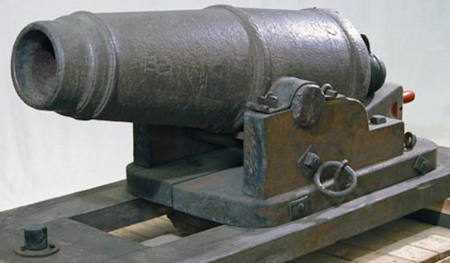
Carronade
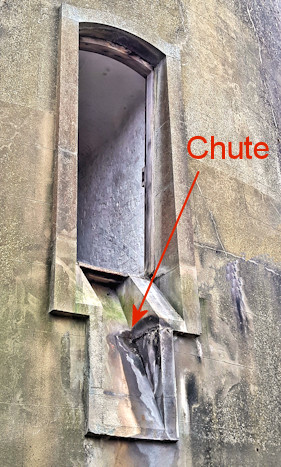
Chute on the first floor entrance to a Martello Tower

Corbel
Death or Glory men: nickname for Brunswick Oels corps (from their badge).
Desagulier: light fieldpiece named after its designer.
Dispart: half the difference between the diameter of a gun-barrel at the base-ring and the swell of the muzzle; generally 1/56 of the length.
Division: tactical formation of two or more brigades.
Dolphin: lifting-handle on a cannon-barrel.
Draft: system of breaking-up a unit to transfer personnel to other corps.
Dumpling: short-barrelled pistol.
Embrasure: opening in a parapet to allow gunfire through the wall.
Enceinte: fortress-wall or perimeter.
Enfilade: fire from a flank.
En flute: a ship-of-the-line with most guns removed.
Ensign: infantry second-lieutenant. Enthusiastics: nickname for 4th Division, Peninsular War.
Envelope: continuous enceinte.
Evolution: drill-movement.
Expense magazine: small magazine placed near a battery.
Family: general's staff.
Fascine: bundle of brushwood used in fortification.
Fausse-braye: low outer rampart.
Felloe (or felly): curved segment of a wheel.
Fencibles: Volunteer force first raised in 1794 by the War Office for home service (including Ireland) and paid on a regular basis
Flint-lock: Mechanism on musket in which a spark from a flint ignites the priming powder and fires the weapon. Find out more
Fighting Division: nickname for 3rd Division, Peninsular War.
Fire Ball: illumination-flare comprising rosin, sulphur, alum powder, starch, saltpetre, mealed powder and linseed oil.
Firelock: musket.
Fireworker: artillery technician.
Fixed ammunition: artillery projectile with propellant and wooden 'sabot' attached.
Flank company: grenadiers and light infantry of a line battalion.
Fly: rapidly-moving infantry waggon.
Forlorn hope: first storming-party into a breach.
Frizzen: An L-shaped piece of steel hinged at the rear used in flintlock firearms, positioned over the flash pan so to enclose a small priming charge of black powder next to the flash hole that is drilled through the barrel, such that when fired the flint scrapes it so as to create a spark. Find out more
Fugelman: soldier during drill from whom the remainder took their time.
![]() top of page
top of page
Gabion: earth-filled wicker basket used in fortification.
Gallery: mine-tunnel.
Galloper: light, shafted fieldpiece without a limber.
Garland: wooden framework holding round shot.
Gentleman's Sons: nickname for 1st Division, Peninsular War.
Glacis: slope descending from a fortification.
Gorget: decorative crescent-shaped plaque worn by officers around the neck.
Grand Rounds: main nightly inspection of sentries.
Grapeshot: artillery ammunition of a number of medium-sized iron balls. Find out more
Grog: a mixture of rum and water.
Guerite: sentry-box, originally one sited on ramparts.
Gun-metal: 'brass' of cannon, generally 8 or 10 parts tin to 100 parts copper.
Half-brigade: half an artillery company.
Half-pay: pay accorded an officer who held a commission but had no employment.
Handspike: lever used to manoeuvre a cannon.
Housings: horse furniture.
Howitzer: light short-barrelled cannon which fired a heavy projectile with considerable accuracy at a high angle of elevation
Instrument (or Desagulier's Instrument): device for discovering internal cracks in cannon-barrel.
Jaggers: nickname of 5/60th (anglicization of German lagers = riflemen).
Jingling Johnny: musical instrument of bells on a pole.
Johnny Newcombe: a newly-enlisted soldier or one unused to campaigning.
Junk Wad: Rope wad which was inserted into muzzle-loading gun between the gunpowder and the shot
Keep: Central tower of a fort or castle serving as a position of last defence
Knapsack: infantry pack.
Laboratory: room or tent where the powder was made into cartridges.
Langridge: coarse grapeshot.
Light Ball: illumination-flare.
Light Bobs: nickname for light infantry.
Limber: two-wheeled carriage connecting cannon with gun-team.
Linstock: pike holding slow-match.
Lobster: colloquialism for a soldier (from the red coat).
Local Militia: part-time 'home guard' formed in 1808.
Lunette: triangular fortification on or beyond a glacis.
![]() top of page
top of page
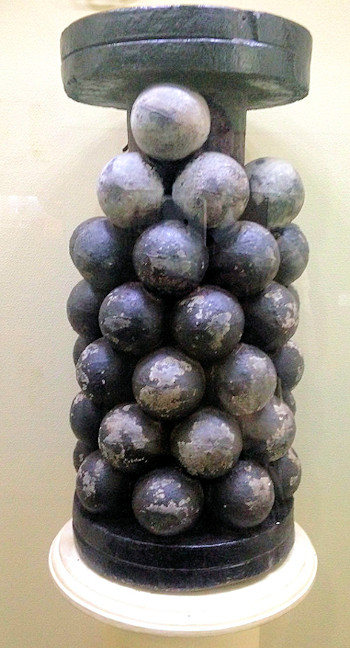
Grapeshot

'Lobster' Red Coat Soldier
Machicolation: gallery projecting from the wall of a tower with openings between the corbels through which fire can be brought on an enemy at the base of the tower
Musket: standard smooth-bore hand-gun used by armies, until made obsolete by the introduction of the rifle in the nineteenth century
Magazine: (1) storage-place for ammunition; (2) extra cartridge-box.
Marching Division: nickname for 6th Division, Peninsular War.
Match: impregnated burning-cord for igniting cannon.
Marquis: large tent, now 'marquee'.
Militia: home-defence force raised partly by ballot.
Mongrels: nickname for 7th Division, Peninsular War.
Mosquito trousers: breeches and gaiters in one piece.
Mother Shipton: tall 'round hat' named after Yorkshire witch.
Music: regimental band.
Musketoon: light musket.
Nature: weight or classification of an artillery piece.
Necessaries: personal kit.
Observing Division: nickname for 2nd Division, Peninsular War.
Old Trousers: British nickname for French drum-call Pas de charge'; thus 'here comes Old Trousers' = 'the French are charging'.
Ordenanca: Portuguese militia.
Outpost: outlying picquet; scouting-work in general.
![]() top of page
top of page
Parallel: siege-trench running parallel to enemy fortification.
Parapet: stone breastwork designed to give the defenders on a wall or tower cover from fire and observation
Pas de souris: staircase giving access to a ditch
Park: artillery reserve.
Parole: (1) system of releasing prisoners-of-war from confinement on their promising not to escape;
(2) password.
Pelisse: (1) furred hussar jacket; (2) officer's braided frock-coat.
Petard: an explosive device for blowing-in a gate.
Picker: wire needle for clearing musket touchhole.
Piece: any cannon (originally 'fieldpiece').
Pioneer: regimental artificer or carpenter.
Pioneers: nickname for 5th Division, Peninsular War.
Picquet: infantry outpost or sentinel.
Portfire: holder for a slow match.
Post: outpost, sentinel.
Pounder: definition of the power of a muzzle-loading gun by the weight of the shot fired
Prepared ammunition: ball and propellant in a cartridge.
Present: to 'present fire' = to aim.
Prog: colloquialism for food.
Prolonge: rope attaching cannon to team to obviate unlimbering.
Provisional Cavalry: similar to Fencible Cavalry.
Provisional corps: composite units formed from detachments.
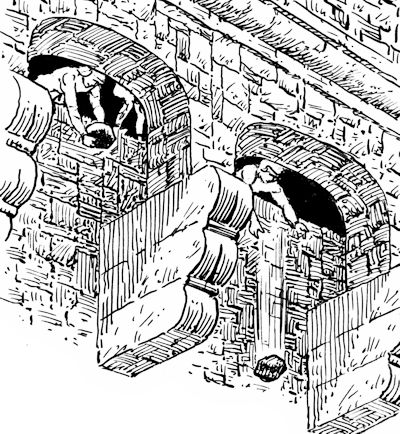
Machicolation
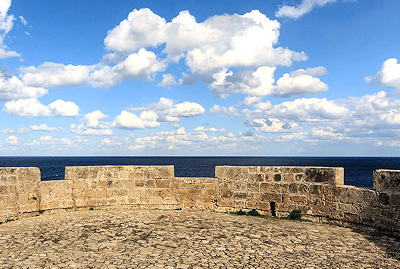
Parapet

Queue: (1) pigtail-hairstyle; (2) tobacco plug shaped like a pigtail.
QF: quick-firing
Quatrefoil: four-cusped figure resembling a leaf with four branches (e.g., a four-leafed clover)
Quick-match: quick-burning match.
Quoin: wooden block used for elevating a cannon-barrel.
Racer: Circular or semi-circular, horizontal metal rail along which the traversing platform of a heavy gun moves.
Rampart: earth or masonry wall forming main defence of fortress.
Ravelin: triangular detached fortification in front of a fortress-wall.
Recruiting regiment: one formed to be split up immediately and the men drafted to other regiments.
Redan: V-shaped fortification.
Redoubt: detached fortification, or a redan in a bastion.
Reinforces: reinforcing-bands on a cannon-barrel.
Render (to): To cover with a coat of plaster
Revetment: retaining-wall of a fortification. Round hat: short 'topper' with wide or upturned brim.
RML: Rifled muzzle loader: type of gun in use between 1850 and1890, just before the advent of modern breech-loading (BL) guns
Running ball: musket-charge without wadding. Sabot: wooden shoe on 'fixed ammunition'.
![]() top of page
top of page
Sallyport: Passage giving access to the ditch for use by the defenders making a counterattack or sortie
Sap faggot: fascine eight inches thick, three feet long.
Sap roller (or `gabion farci'): gabion rolled in front of a sapper to shield him from enemy fire.
SB: Smooth-bore
Sea Fencibles: naval home-defence volunteers based in sea-ports. Find out more
Sentinel: sentry.
Serpent: woodwind musical instrument.
Shell: (1) explosive artillery projectile; (2) sleeveless jacket.
Shot: Non-explosive solid projectile fired from a muzzle-loading gun
Skilly: thin, watery soup.
Slow-match: rope fuse which was slow burning.
Smoke Holes or Vents: small circular holes above windows in forts/Martello Tower that dissipate musket smoke in times of siege.
Spadroon: straight-bladed, light sword. Spatterdash: long gaiters.
Spherical case: shrapnel shell.
Spontoon: half-pike.
Stirabout: stew or stock-pot.
Stock: leather strip worn around the neck.
Storm-poles: palisade planted on a scarp, projecting horizontally or slightly downwards.
Stucco: Coarse plaster or cement used to cover the exterior surfaces of walls
Subdivision: one artillery-piece, crew and waggon.
Substitute: militiaman paid to serve in place of one selected by ballot.
Suffocating pot: sulphur/nitre composition, when ignited causing distress to the enemy, or used for fumigation.
Sugar-loaf: any tall, cylindrical head-dress.
Supporting Division: nickname for 4th Division, Peninsular War.
Sweeps: (1) nickname for 95th Rifles (from dark uniform); (2) (nautical): oars.
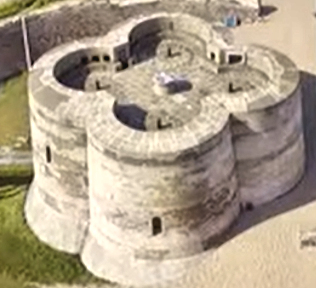
Quatrefoil Martello Tower
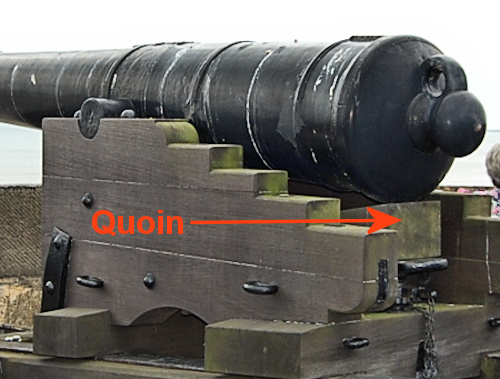
Quoin
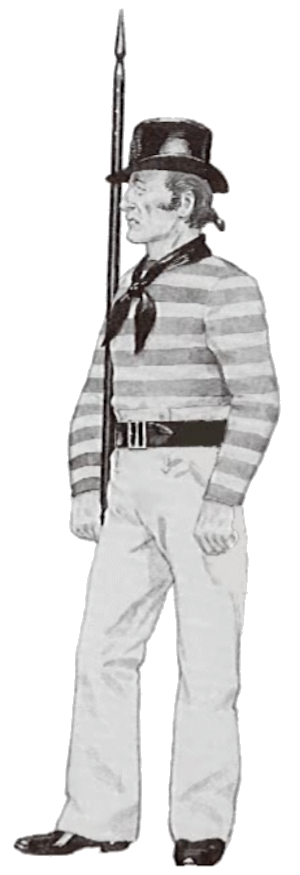
Typicla Sea Fencible
Tarleton: fur-crested light dragoon helmet, named after General Banastre Tarleton.
Terreplein: area on top of a rampart or tower and surrounded by a parapet where guns are mounted
Tete de point: fortification defending the approaches to a bridge
Tin helmet: lightweight cavalry helmet for tropical use.
Toise: old French unit of measurement, used for measuring fortifications; = 6.395 English feet.
Tow Rows: nickname for grenadiers (from the chorus of the march British Grenadiers).
Trefoil: Three-cusped figure resembling a leaf with three branches (e.g., a shamrock)
Triangle: framework of spontoons to which a prisoner was tied before flogging.
Truck: small, solid wheels for artillery carriage.
Trunnions: projecting-lugs on a cannon-barrel. fitting onto the carriage.
Turban: cloth strip around a helmet.
![]() top of page
top of page
Valenciennes composition: an incendiary mixture of saltpetre, sulphur, antimony and Swedish pitch.
Vedette: cavalry scout.
Volunteers: (1) part-time 'home guard'; (2) aspirant officers serving in the ranks until a commission became vacant. Find out more
Wadmiltilt: waterproof tarpaulin made of wool. retaining the natural oils of the sheep.
Wallpiece: Small, muzzle-loading gun usually mounted on the wall of fortress and traversed by means of a swivel (sometimes called a swivel gun)
Waterdeck: waterproof, painted canvas saddle-cover.
Water fascine: fascine weighted with stone :c make it sink into marshy ground.
Watering cap: cylindrical shako worn by cavalry in undress uniform, orig when watering horses. Watchcoat: greatcoat.
White light: see 'Chinese light'.
Wing: (I) half an infantry battalion (or more loosely any element of a battalion);
(2) shell-like epaulette worn by flank companies.
Whiskers: facial hair, moustaches, etc; also used as a colloquialism for grenadiers, who at times wore moustaches.
Wolf-pit: cone-shaped pit used as anti-personnel: trap; also trou de loop.
Worm: corkscrew-device for extracting an unfired charge from a gun-barrel.
Zigzag: approach-trench in siege warfare.






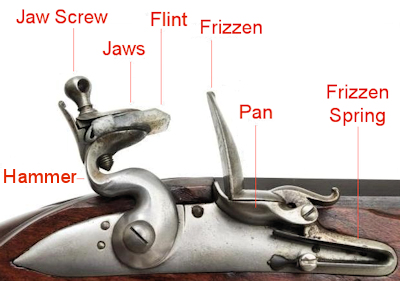
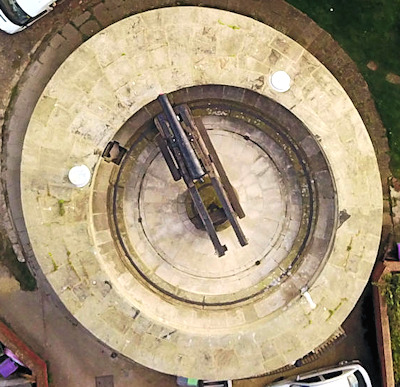
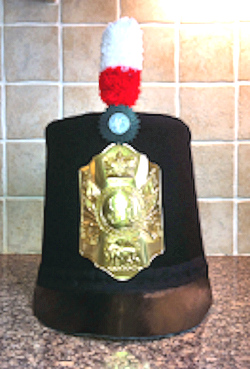
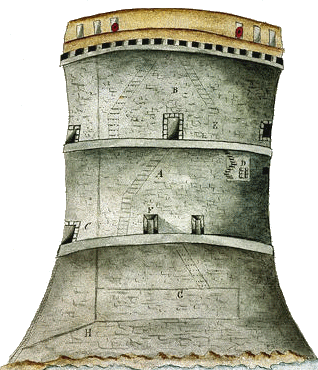



 Red Dragon I.T. Ltd.
Red Dragon I.T. Ltd.